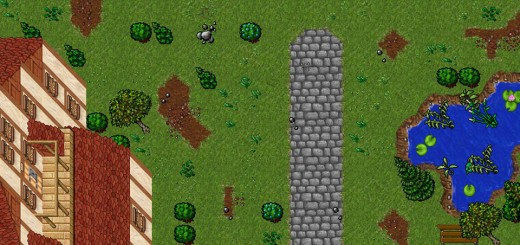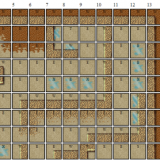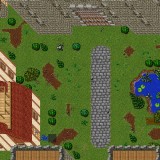Pits Of Doom Lesson 1: Planning Stage
Before you start any kind of online game you need to take a minute to sit down and consider some of the following questions:
- What is my game called?
- What is my target audience?
- Can I afford the cost and time of manging my own game?
- Am I good at working with people?
- What competition already exists for the game I’m going to make?
- How will my game work?
It’s All In A Name
A name can make or break a game. Pits of Doom isn’t anything exciting, but this is a tutorial game, not something I’ve made to produce to lots of people. Your name should be memorable, but not too hard to spell, say, or remember. Shorter names seem to work better as well, but that’s more of a personal preference.
Hit the Target
Many people overlook target audiences. When you design your game you need to keep in mind who actually plays your game. If your game is for young children then you don’t want a game that’s overly complex, hard to navigate through and has few images. Also take into account your audience’s familiarity with computers and the Internet. A child isn’t as likely to be able to understand complex directions or sequences whereas a hard core video game addict should have no problem navigating menus and following technical directions.
Audience Tips:
- Games made for ages 5-7 should have lots of pictures, big buttons, be easy to play, and have few words to keep younger children interested. There should be lots of games, puzzles, animations, and things to keep kids from getting bored. A suggestion would be using popular cartoon characters as they play the game.
- Games made for ages 8-17 should have more text, but also a lot of pictures. You want to make sure it’s easy enough for the younger players to get around and play, but hard enough to keep the interest of older players. Most games made for teenagers will automatically attract younger kids and adults at the same time.
- Adult games have more of a risk. Keeping younger players from seeing what they shouldn’t can be a hassle. One thing to keep in mind is that if younger viewers see content they shouldn’t you could be getting some very angry messages from parents of younger players. A suggestion would be using some kind of way to make sure the player is over 18, such as needing to give a money transaction to play. For an adult game you can assume they have decent computer skills and are possibly hard core gamers. Complexity and strategy and action should play big parts in these games.
- A mix of all ages is the hardest challenge. Games have to have a mix of easy play, medium play, and hard play for all age levels. You’ll have to manage keeping the attention of all age groups. This usually happens on its own if you have a really popular game, because everyone wants to play no matter what his or her age is.
Carrying the Costs
Games are inherently expensive. The bigger and more popular your game becomes the more it’ll cost you to keep it up and running. Are you willing to put up the expensive of domain names, servers, bandwidth, hardware upgrades, technical support, and so forth and so on? My biggest game has over 100k members and costs me over $300 a month just in server costs. That’s over $3,600 a year just to keep the game server online. Then you have to factor in advertising, domain names, and additional expenses such as postage and letter heads and office supplies. Will you be able to carry the costs of the game’s expenses if your game isn’t generating enough revenue to support itself? These are all really important questions. Take the time to research how much it costs to buy a domain, get hosting setup, and any other additional fees you may run into before you start.
Cost Solutions
Just because you don’t have a big budget, don’t let that limit you!! There are several things you can do to limit your expenses.
- Limit the numbers of members who can join your game. This will reduce your bandwidth — the amount of data passed back and forth over the internet — and will encourage your members to stay active. You can even go through and delete accounts that are inactive after a certain period of time.
- Limit how many people can play online at a single time. This isn’t the best solution, but sometimes it’s a good option if your game is popular but you don’t have many people that play online at any particular time during the day.
- Don’t expand your hosting/server needs as your costs increase. If you can’t afford it, then you can’t afford it. Make your members deal with slower response times and hangups. Not great for customer service but at least they can all play.
- Don’t advertise. I know this goes against the grain, you make a new game and you really want to share it, but I’ve found word of mouth is the biggest and best form of advertising out there. The more people that know about your game the more will want to play and the higher your expenses.
- Make your game a “friends only” game. Limit it to people you know or friends of people you know. If it’s just a game you plan on making as a hobby, something to do in your spare time, this is a great alternative.
I’m a People Person
Even if you aren’t planning on it, your game will generate a lot of interaction among people. People will email about problems or questions or help constantly. If you’re not great with people or you can’t be bothered then you’re in for an eye opener. A website without any kind of support doesn’t do well in the big scheme of things. Take the time to evaluate yourself. Are the benefits worth the downfalls?
Overtake the Competition
Is your game 100% unique? Chances are that it’s not. Take a day or two to find any other site you can that’s even a little bit similar to the game you have in mind. Join them and check them out. What are features you like? What do you dislike? The more time you spend going through your competition’s setup the more you’ll generate a feel for what you want your own game to be like, what features are a given, or could be improved upon. Knowledge is power, and giving your target audience a more useful, more enjoyable game is sure to win their approval and guarantee your popularity.
Liability & Legal Mumbo Jumbo
Terms and conditions or terms of service are a legal agreement between you and anyone who decides to play your game. In this agreement you want to make sure that anyone who uses your website cannot sue you or take you to court!!! Every game you make should have terms and conditions. If you can afford it I highly recommend that you pay a lawyer to write them for you or review what you’ve written up yourself. If not you can take use a copy of the terms and conditions I’ve drawn up for Pits of Doom at the end of this tutorial as a starting point for your own game. Listed below are some general things I would recommend thinking about or including in your terms. Please note this is not legal advice and any tips below are no substitute for getting a lawyer whose familiar with current online practices and laws.
Protect Yourself:
- Make sure you state that by using your website your visitor is legally tied to your Terms and Conditions. This means that they accept them as legal document.
- Make sure you remind your visitors that any changes made to your Terms and Conditions are in place immediately. You don’t want people to tell you they never agreed to your changes.
- Don’t forget to include a statement saying that your visitors can’t hold you responsible for any kinds of fees or losses as a result of using your website. This includes computer problems, buying products off your website, game fees, etc.
- If you make people pay to access your game then you should have a section describing your refund policy – even if you don’t give refunds, tell them that. A refund means you’ll give someone his or her money back. For example if someone paid you twenty dollars and asked for a refund you’d give them their twenty dollars back.
- Be extra careful to protect yourself from things members may put up on your game. Include something saying you’re not responsible for any links, explicit or harmful text/pictures, services or products displayed on the site by members, third parties (people outside members), links and advertisements.
- Remind site visitors that you’re not responsible for any information they share or give out to other members or other places found through your website.
- Mention that visitors post content on your site at their own risk. This lets them know they’re responsible for their own actions.
- Describe your cancellation of accounts. This means you write out why you can delete or ban someone’s account and for what reasons. For example, you can include that if someone cheats or breaks a rule then you can delete their account. If your visitors are paying to play you might want to tell them they can or cannot get their money back for having their account deleted or banned.
- Always have rules. Rules state what is and is not acceptable on your website. Make sure you include harassment, rude or nasty comments, server abuse, emails, etc.
- Add anything else you need that I didn’t mention. Your terms and conditions should be your lifeboat when you’re drowning. Everything you need or think you need should be on board. If you’re not sure if you should add something or not, add it. They can be as long or as short as you want, but it’s always best to be safe now instead of sorry later.
Privacy Policy
A privacy policy lets your members know how you’ll be using any information you ask them. For instance, if you asked a member for their address and telephone number when they joined you might have plans to call them or send them regular mail. Some people don’t like this and others are fine with it. In your privacy policy you should tell people how you plan to use the information they give you when they join your game. So in the example above you would say that if members give out their telephone number they’ll receive phone calls, and if they give out their home address they’ll receive mail. This way people know exactly what happens to the information they give you.
Laws You Should Know About
There are several Internet laws you should concern yourself with if your game is based in the USA. Reading them isn’t an option of whether or not you feel like it, they are a must read. If your game is based outside the USA you’ll need to research yourself to see what rules and regulations you have to comply to.
If your game allows children you need to read the COPPA act. This concerns the privacy of personal information you may gather from children under the age of 13, how it must be stored, and who can have access to it.
Whether your game allows children or not you need to read the Digital Millennium Act. This is one of the largest and most important laws that pertains to you as an Internet game. It outlines things from playing music from current artists on your website to allowing members to upload pictures, videos, and any other content. Knowing about the DMA will protect you from copyright infringement lawsuits which will become one of your biggest concerns as your members generate their own content using or interacting with your game.
Some other minor laws include the Internet Tax Freedom Act and the Communications Decency Act both of which are fairly self explanatory from their names.
Business Licenses
Most counties of USA states require you obtain a business license if your game is generating over x amount of revenue a year. Usually you’re charged based on your annual income and the fee’s are fairly minimal if your game is making less than $10,000 a year. You can usually get an application from your local chamber of commerce or county treasury. You will typically be charged once or twice a year.
Sole Proprietor vs LLC
A sole proprietor is one person who owns an entire business or service. If your game is just a hobby chances are you’ll never need anything else other than this. All revenue you make from your game must be claimed on your personal income tax and your tax return will be calculated as if it was a part of your typical salary. In most states you don’t have to report additional income unless it exceeds $5,000 but you’ll need to check your state laws to confirm that.
An LLC, or limited liability company, is the other option. It separates you from your game and removes the chance that someone can sue you as an individual. Instead they must sue the game itself which means there’s no possibility you could loose your house or car or property. If your game is making more than $5,000 a year in revenue an LLC or something similar should be in the works.
Copyrights
Inherently anything you make yourself is automatically copyrighted by you, even if you never file copyrighted paperwork or register a trademark. However in a legal case having a certified copyright is a must.
A copyright is easy and fairly cheap to file. You can do it online now through the Electronic Copyright Service. It costs about $35 per copyright and takes anywhere from 6-8 weeks to have it approved. Once the copyright is approved you’ll get an official letter with a copyright identification number. Now you have a legal document verifying you hold the copyright to your game.
A copyright filed after January 1st, 1978 for a single author will last for the life of the author plus an additional 70 years. A copyright filed for joint authors will last until the life of the last surviving author plus 70 years. If you ever decide to sell your game you can easily transfer your copyright from you to the new legal owner.
Trademarks
These are a bit tricky. I wouldn’t ever try and register a trademark without a lawyer, there are just too many inns and outs and little things you have to know about. A trademark costs anywhere from $275 to $325 depending on the classes you register it for. As your game gets more popular a trademark will ensure you own all legal rights to name branding, products and any additional services that arise as your game grows.
The biggest problem with trademarks is trying to find a unique name. If your trademarked name sounds too much like other trademarked names it will be denied. If your trademark is spelled differently but phonetically sounds the same it will also be denied.
Trademarks are expensive but well worth it as your game expands and grows. You can file trademarks electronically at the Trademark Office.
Gambling & Gaming
This might not seem like something you’d think about as you’re developing a game but it is something you need to be aware of. If you offer “pay for play” gaming where your members will win prizes as a result of playing your game this is considered gambling. Gambling is defined as playing a game for money or property, or betting on an uncertain outcome.
In many states gambling is illegal without a proper license. In some states it’s illegal period. If your business model is considered gambling you’ll need to make sure you can get a license for it. Then you also run into the problem of making sure that you only have members from states where you have a valid gambling license. Over the Internet this is fairly hard to do.
For instance, let’s say you have a legal gambling license in West Virginia where your business is based. Your website attracts individuals from all over the United States. Someone from Virgina signs up and starts playing your game. Almost all forms of gambling in Virginia are illegal unless sanctioned by the state itself. Now you have someone illegally gambling on your website which could lead to future complications for yourself.
So how do you get around it? Simple, you don’t. Charging money for your game cannot be tied to winning any kind of prize or property. That means you could charge members for something completely non-related to a prize you’re giving out, or allow both paying and non-paying members to have an equal chance of winning the prize. If a member doesn’t have to pay anything in order to win a prize then it’s not considered gambling.
Gears & Cogs
Now it’s time to set your brain into motion. Write down the biggest features you want to include in your game. Then go ahead and break it down into smaller pieces. This will help you express all of your ideas before you start making anything and should increase the usability of anything you end up making.
Putting It All Together — Pits of Doom
Here is something I’ve thrown together to give you an idea of the thought process I went through when coming up with the Pits of Doom game.
I chose a really generic name for this game simply because it’s a tutorial on making your own online game. Here are some names I might consider if this was a game I was making as a serious revenue earner:
Black Abyss
Infinity Nights
Dark Haven
The target audience for this game is boys between the ages of 12-18. That means they’re all in middle school or higher. They’re probably used to seeing shoot em up/slasher video games by this age. Most of them have a fairly high computer usage skills at this point, but some of them are young enough to struggle. That means my navigation and layout should be simple to a point, but maybe the game play can be much more complicated.
Some similar online fighting games are:
games.swirve.com/utopia/ – an online strategy game. I find this one to be way too complicated for younger players. It has some great ideas, but it’s a bit overwhelming when you go in to play for the first time.
www.elveron.com – what do you think about this one? Follow the link and ask yourself, what do I like, what don’t I like? What could be done better?
Now write down some similarities you saw. What about the differences? Things that are similar in all games are probably features you’d want to strongly consider having yourself, or to some variation. Those are things that have made these games popular.
This game isn’t ever going to go up on any of my servers except for this tutorial code, so it won’t cost me much of anything to maintain. Can’t afford the cost of having a game online but still interested in learning how to make one? No problem, all you have to do is download and install XAMPP. Now you can run the game right on your own computer at home. Once it’s installed you can setup a database and get busy. Need more help getting XAMPP up and going? Try this tutorial.
Finally, I took the time to define the features I’ll be adding to the game and broke them down:
Game World –
Each map in the game is called a map node.
There can be an unlimited number of map nodes in the world.
Map Nodes –
Each map node has a name, a description.
Each map node can have unlimited coordinates.
Coordinates –
X, Y, Z value.
Has 1 object associated with it.
Wall value:
- 0 = open, they can move to that coordinate
- 1 = there is a wall here
Has 1 transfer node associated with it, detailing that moving to this coordinate will force the user to move to that coordinate on the new map node.
Has a level associated with it, detailing that moving to this coordinate will force the user to move up or down one level.
Item Objects –
G = gold (random amount each time)
T = treasure
S = sword
A = armor
L = lantern
O = oil
H = shield
C = enemy creature/monster
X = pit, chance of them dying, or draining all magic, or dropping to a lower level
T = health tonic
M = magic potion
S = store where they can buy items
L = ladder, you can climb up or down to another level
Characters –
These are owned by members.
They have a name, gender, and breed (monster, human, elf, dwarf, centaur, fairy).
When the members is online, they are always associated with an active coordinate.
They can equip items and use them to help their statistics.
The more they play the higher the character’s statistics go.
Statistics Include:
Health
Speed
Inteligence
Strength
Agility
Fighting Level
Magic Level
Magic Amount – how much magic they have they can currently used
Weapon Equipped
Spell Equipped
Armor Equipped
Shield Equipped
Characters can fight other characters and monsters in the game.
If a character kills another character then they get to keep all of the items the character they killed had equipped and any gold they’d collected in the past 20 minutes.
Characters can trade items with each other if they’re both on the same coordinate.
Members –
Has a username, login, and password.
Keeps an email to send them password information.
Keeps track of when they are online or offline so it can activate their character.
Starts off 500G
It costs 100G to create a character.
Members can trade in gold for better weapons, however they must get the character to a store first.
When a member is online all of their characters are active in the game.
Members can trade any item they have among their own characters even if they aren’t on the same coordinate.
As soon as a member logs off or closes the game window all of their characters go inactive unless they are currently being fought by another character or attacked by a monster.
Mail –
Members can send messages to other members in the game.
Messageboard –
Members can post on a community message board.
Best of the Best –
Top members and characters in the game.
Oldest characters in the game.
Strongest characters in the game.
Game Objective –
The objective of this game is to navigate around the game world and gain prestige for your characters by keeping them alive as long as possible.
The more characters you have the easier it is to explore the world but the harder it is to keep all of them alive.
Pits are one of the biggest hazards in the game, they continuously drop you to lower and lower levels. The lower you are on any map the harder the monsters are to defeat.
Pits –
If you run into one of these you will have one of these random possibilities:
Die
Loose all your money
Loose your best item
Loose all your magic strength
Loose all your value in 1 statistics area
Have one value in your statistics areas cut in half
Be teleported to a random location on any map
Drop down to a lower level (if there is one).
Monsters –
These are automatically generated by the game. The further down you are on any map the harder they are to defeat but the bigger the reward for killing one.
Player Movement –
You won’t be able to tell if you’ve hit a wall, a pit, or an empty space until at least one of your players has explored the map already. That means you have to visit the entire map before you can see what the map looks like from a top down view. This makes it more exciting as you won’t know what you’ll find until you go there.
Phew! That’s a lot but this is actually a fairly straight forward and small game. I’m sure you can already think of a hundred different things you would or could add to it from what I’ve described already.
Now, you’re ready to start learning how to make this game. Go to lesson 2.














I was reading through all the legal issues, and I was thinking about moderators. If a website chooses to have moderators as volunteers what kind of laws are there in a website that targets mainly 8 to 17 year olds?
A volunteer is essentially an unpaid employee so you’d be held responsible for them the same way you would an employee. Also, you’d have to take COPPA act into consideration. To be COPPA compliant you’d have to provide contact information for the individual who has access to personal information of minors. I suggest you read up on the COPPA act and the employee laws for your state.